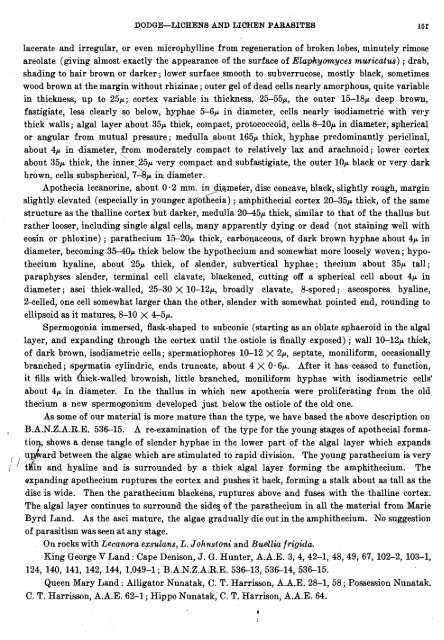You also want an ePaper? Increase the reach of your titles
YUMPU automatically turns print PDFs into web optimized ePapers that Google loves.
DODGE--<strong><strong>LICHEN</strong>S</strong> <strong>AND</strong> <strong>LICHEN</strong> <strong>PARASITES</strong> 151<br />
lacerate and irregular, or even microphylline from regeneration of broken lobes, minutely rimose<br />
areolate (giving almost exactly the appearance of the surface of Elaphyomyces muricatus) ; drab,<br />
shading to hair brown or darker; lower surface smooth to subverrucose, mostly black, sometimes<br />
wood brown at the margin without rhizinae ; outer gel of dead cells nearly amorphous, quite variable<br />
in thickness, up to 25p; cortex variable in thickness, 25-55p, the outer 15-1BP deep brown,<br />
fastigiate, less clearly so below, hyphae 5-6p in diameter, cells nearly isodiametric with ve1.p<br />
thick'walls; algal layer about 35p thick, compact, protococcoid, cells 8-lop in diameter, spherical<br />
or angular from mutual pressure; medulla about 165p thick, hyphae predominantly periclinal,<br />
about 4p in ,diameter, from moderately compact to relatively lax and arachnoid; lower cortex<br />
about 35p thick, the innk 25p very compact and subfastigiate, the outer lop black or very dark<br />
brown, cells subspherical, B 7 p in; diameter.<br />
Apothecia lecanorine, about 0.2 mm. in diameter, disc concave, black, slightly rough, margin<br />
/<br />
slightly elevated (especially in younger apothecia) ; arhphithecial cortex 20-35p thick, of the same<br />
structure as the thalline cortex but darker, medulla 20-45p thick, similar to that of the thallus but<br />
rather looser, including single algal cells, many apparently dying or dead (not staining well with<br />
eosin or phloxine) ; parathecium 15-20p thick, carbonaceous, of dark brown hyphae about 4p in<br />
diameter, becoming 35-40p thick below the hypothecium and somewhat more loosely woven; hypothecium<br />
hyaline, about 25p thick, of slender, subvertical hyphae; thecium about 35p tall;<br />
paraphyses slender, terminal cell clavate, blackened, cutting off a spherical cell about 4p in<br />
diameter ; asci thick-walled, 25-30 X 10-12p, broadly clavate, 8-spored ; ascospores hyaline,<br />
2-celled, one cell somewhat larger than the other, slender with somewhat pointed end, rounding to<br />
ellipsoid as it matures, 8-10 X 4-5p.<br />
Spermogonia immersed, flask-shaped to subconic (starting as an oblate sphaeroid in the algal<br />
layer, and expanding through the cortex until the ostiole is finally exposed) ; wall 10-12p thick,<br />
of dark brown, isodiametric cells; spermatiophores 10-12 X 2p, septate, moniliform, occasionally<br />
branched; spe matia cylindric, ends truncate, about 4 X 0.6~. After it has ceased to function,<br />
it fills with L ick-walled brownish, little branched, moniliform hyphae with isodiametric cells'<br />
about 4p in diameter. In the thallus in which new apothecia were proliferating from the old<br />
thecium a new spermogunium developed just below the ostiole of the old one.<br />
As some of our material is more mature than the type, we have based the above description on<br />
B.A.N.Z.A.R.E. 536-15. A re-examination of the type for the young stages of apothecial formatioy,<br />
shows a dense tangle of slender hyphae ill the lower part of the algal layer which expands<br />
; i<br />
u&ard between the algae which are stimulated to rapid division. The young parathecium is very<br />
: ' tdin and hyaline and is surrounded by a thick algal layer forming the amphithecium. The<br />
expanding apothecium ruptures the cortex and pushes it back, forming a stalk about as tall as the<br />
disc is wide. Then the parathecium blackens, ruptures above and fuses with the thalline cortex.<br />
The algal layer continues to surround the sides_ of the parathecium in all the material from Marie<br />
Byrd Land. As the asci mature, the algae gradually die out in the amphithecium. No suggestion<br />
of parasitism was seen at any stage.<br />
On rocks with Lecanora exslllans, L. Johnstoni and Hudlia frigicla.<br />
King George V Land : Cape Denison, J. G. Hunter, A.A.E. 3,4,42-1, 48,49, 67, 102-2, 103-1,<br />
124, 140, 141, 142, 144, 1,049-1; B.A.N.Z.A.R.E. 536-13, 536-14, 536-15.<br />
Queen Mary Land : Alligator Nunatak, C. T. Harrisson, A.A.E. 28-1, 58 ; Possession Nunatak.<br />
C. T. Harrisson, A.A.E. 62-1 ; Hippo Nunatak, C. T. Harrison, A.A.E. 64.

















